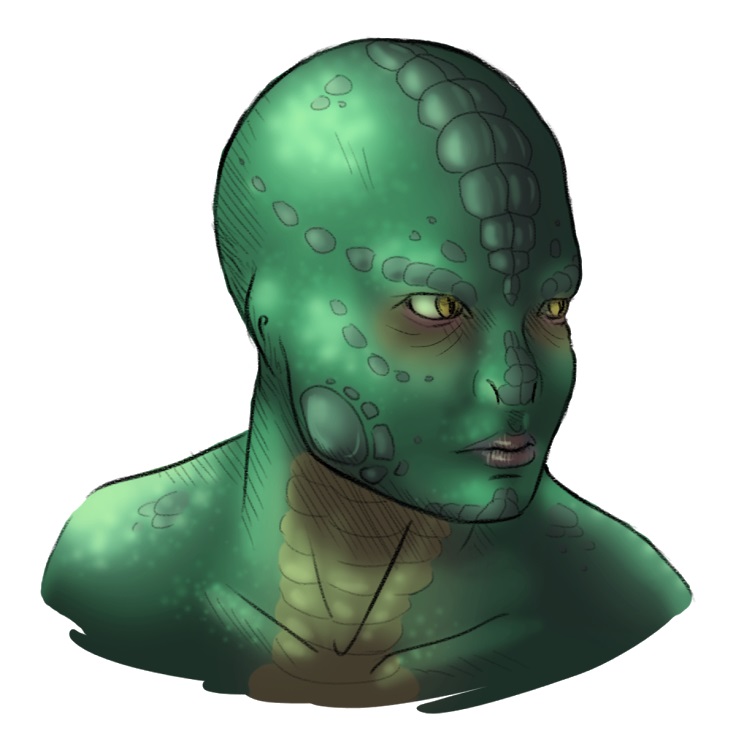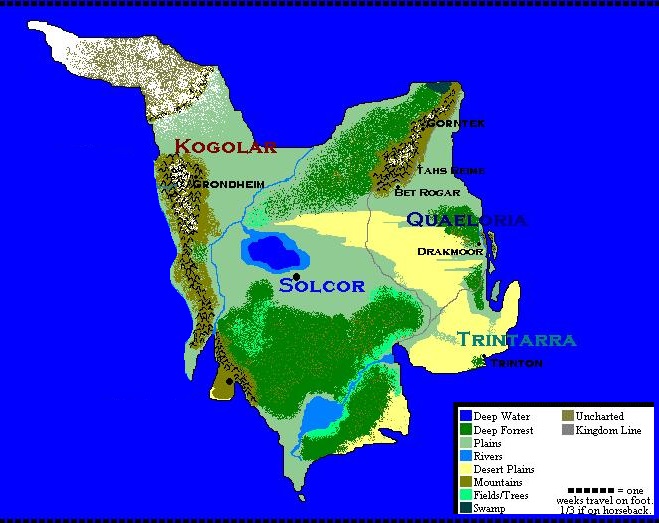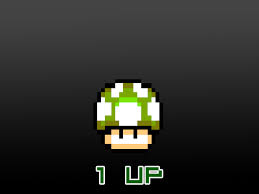|
World Of CRUX
|
Character Creation
|
|
Character Update
|
Play Online!
|

|
RACE
Ilsk
+1 to Vitality Immune to Water attacks Elemental Ice |
|
GOVERNMENT
Tribal
Chieftan: Dahulu |
|
SPECIAL
Excellent swimmers.
|
|
RESOURCES
Pearls
|
Legend says, in the ancient days of Ocanna, the island was oddly quiet. Birds chirping, the sounds of waves crashing, and the occasional gust of oceanic wind through the palm trees was the music of the island. A day soon came to pass, when the Ilsk say the great scale was washed ashore during the first new moon on the 1st of Respite of a new year. No one knows from whence the scale came, only that it was birthed by the Mother Ocean. The scale nestled into the sands as the nurturing waves of Mother's Tide washed over it. There, in the new moon, the first of the Ilsk were born, or as it is referred to today, “The Great Hatching”. The newly hatched Ilsk believed they were alone, and struggled in their infancy. The hatchlings, however, were not alone. The Siphonte had been there long before, and in their wisdom, saw opportunity for their beloved island to grow thanks to this gift from their Mother Ocean.
The Siphonte knew not to intervene in the development of the Ilsk, as that was their journey. Hunting, gathering, and building huts were among many things the Siphonte taught their new scaled friends, and thanks to their caretakers, the Ilsk grew and prospered into the first adult tribe. But what is a tribe without leadership? How would they choose?
While on a hunt one of the first Ilsk, Utari as she was called, caught her tail in a twisted branch of a palm, forcing her tail to separate from her body. The hunters decided to call off their hunt for the day and returned to the village to care for Utari. Several days later, her tail had healed and grown to a nub, which looked to be slowly repairing itself. Now having no tail with which to fight, Utari fashioned herself a sharp weapon with slate rock. The remainder of her tail dried into a hard husk, and was turned into a scabbard for her new weapon.
The first tribe, came to be when a single male Ilsk, Iskandar, suggested the group needed a leader. For days the now adult hatchlings argued over how to choose something so important. Utari, now healed, emerged from her hut and suggested a battle. “We fight until only one tailed among us remains..” she suggested. Many balked at the idea of becoming separated from their beloved tails, but Iskandar refused to back down from any challenge.
Accepting the terms, he dared anyone to challenge him for the right to lead. Many fought, and none persevered in victory against Iskandar, and thus, he became their first Chieftain. Taking Utari as his mate, they soon gave birth to the first clutch of Ilsk to be raised by their race. In suit, the rest of the tribe followed and began having clutches of their own, raising them in their palm huts among the sands and tides.
Of Sands and Tides:
As with many of the animalia of Crux, you are one of the older races, older even than many of the animalia themselves. Your scales denote a long lineage descended from ancient times, with minimal change in physical appearance over such a span of years. As with any tribal race, over decades they would migrate. Some made their way closer to their Mother Ocean, and some stayed inland on the warm sands.
The Ilsk who made their way to the waters edge were the fisherman of their race. Their scales are smooth, flat, broad, and have brighter color than their inland brethren. Giving birth to clutches only on the new moon, they bury them in the sand in tradition of the night they were birthed. The inland Ilsk come to the waters edge on the new moon to welcome in the new hatchlings annually, bringing along their own live birthed young.
Inland Ilsk have a more neutral coloring, with sharper, smaller scales typically accompanied by small horns along the forehead and down the cheeks.Living among the Siphonte, they have learned to blend in with their neutral tone and sandy appearance, aiding them in camouflage. As the sands are dry, and the heat tends to be unforgiving, the inlanders give birth to live young. These young are incredibly weak for the first few weeks of life and are generally cared for by the women of the village. During their unstable first weeks, the men take over both gathering and hunting.
Culture:
Despite their differences in evolution, both types of Ilsk interact on a regular basis. The tribes of the island come together for births, marriages, and celebrations. Guided by their own Chieftains, there is one Tribe Elder who oversees them all. Any Ilsk upon receiving this title, strips themselves of their name, and is known only as “Dahulu”. The Dahulu, once chosen, is given a blade formed from sea glass with a scabbard. The scabbard is said to be made from the leather of Utari’s tail, and is a sacred item among the Ilsk.
Choosing Chieftains by combat has remained tradition. When a new Chieftain is to be placed, a great battle is held, and all of the tribes attend. Occasionally, a member of another tribe will take part in the combat or “Utari”, after it’s namesake, and fight to join and lead another tribe. Though this is rare, it has occurred.
Ilsk are greatly skilled in combat, and find that this skill is aided primarily by the use of their tail for balance. Chieftains often have the longest tails, due to being the most proficient warriors.
As such, when a member of the tribe is found guilty of a crime, a section of their tail is cut off by the Dahulu. More of the tail is taken for more of a crime, and they are exiled from the tribe until it has grown back.
Though, not all members of the tribe are missing their tails due to dishonor. When the Ilsk are in battle, they may lose some or all of their tail, this is frequent, however, when an Ilsk loses a duel or an important fight, they cut off their tail to represent this loss.
Advantages & Disadvantages of being Ilsk:
The Ilsk ability to move swiftly in water is carried by all types of Ilsk. The swamp is the easiest condition for them to move through, which is interesting considering that it is the condition where the ocean meets the sands and dirt. The Ilsk have grown to believe that their prowess in swamp conditions is Mother Oceans way to remind them that both types of Ilsk are born of The Great Scale, and that they are family and must always meet in the middle during hardships. Their rough scales on their skin also gives them a small measure of protection. Advantages- Vitality and immunity to water based attacks
Disadvantage- They are vulnerable to lightning, both natural and magically summoned. Their views on leadership by aggression makes it difficult for them to parlay in the political world.
Common Knowledge:
The Ilsk are not typically what one would think of a Lizard-folk to be like. They are a tribal, clan oriented people giving great care and attention to family values and their lineage.
Thoughts on the other races of Ocanna:
While the Ilsk are naturally aggressive, the elders of their clans understand the need for living in harmony with the other races of their island.
The Phistian and the Ilsk are rather indifferent to one another. The Ilsk are warrior tribes, and the Phistian tend to be quiet folk. They trade in farmed goods from the Phistian and meats from the hunting outings of the Ilsk. The Phistian appreciate the Ilsk’s ability to protect the island.
The Siphonte and the Ilsk are very close, existing in one another's lore. The Ilsk trade with the siphonte and though their societies are different, they live in harmony together.
The Ilsk, being an aggressive battle worthy people, are typically avoided by the Orsienne. It has also been noted that on occasion, younger Ilsk will attack the Orsiene, as they smell similar to the bird prey that the Ilsk hunt. The Elder Ilsk try to dissuade this behavior in the name of harmony, and the Orsiene elders hold no ill will for the Ilsk. Children will be children. Elder Ilsk and Orsiene have a mutual respect for one another, and the Orsiene also warn the Ilsk, who are vulnerable to lightning when there is a storm coming.



